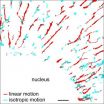LUND, SWEDEN, March 08, 2011 (Press-News.org) NeuroVive is pleased to announce that it has signed an agreement with the European Brain Injury Consortium (EBIC) to conduct a European multi-center Phase II/III clinical trial of NeuroSTAT for neuroprotection in patients with traumatic brain injury (TBI). The goal of the collaboration is to secure the highest possible study quality and compliance with clinical standards to support NeuroSTAT's rapid progress toward commercialization. To this end, NeuroVive will work closely with EBIC's key European experts in the field of neurotrauma and acute brain injuries.
NeuroVive will manage the study in close collaboration with the EBIC group and a clinical research organization (CRO) to be selected. The collaboration with EBIC includes development of the study protocol, site selection, patient recruitment, and statistical support. This adaptive design Phase II/III study will determine the safety and efficacy of NeuroSTAT in moderate to severe TBI.
TBI is a leading cause of death and disability among a predominantly young male population, mostly victims of motor vehicle accidents. TBI is composed of two stages: a first stage of initial brain damage; and a second stage of mitochondrial collapse inside brain cells leading to additional cell death, brain damage and disability. The active agent in the NeuroSTAT formula is a proven mitochondrial protector that in animal studies is a potent neuroprotectant against TBI. There are over 10 million TBI cases per year worldwide. Annually in the U.S., head trauma sends two million people to the emergency room and a half a million have injuries severe enough to be admitted to the hospital. TBI kills 50,000 people and leaves 80,000 people disabled. The annual market for an effective TBI drug is estimated to exceed US$1 billion in the U.S. and Europe.
NeuroVive CEO Mikael Bronnegard comments:
"We are very pleased to collaborate on the NeuroSTAT Phase II/III clinical trial with a highly respected organization like EBIC, comprising key opinion leaders and medical experts in the field of neurotrauma in Europe. Through this collaboration, we have an excellent opportunity to advance the development of NeuroSTAT toward clinical use in treating millions of TBI patients worldwide."
Professor Andrew Maas, Chairman of EBIC, Professor and Chairman Department of Neurosurgery at University Hospital Antwerp, Belgium comments:
"This clinical trial is of great interest to us. The need for international collaboration in the conduct of research in the clinical management of head injury has never been greater, but rigorous evaluation must be carried out on a range of approaches that include new pharmacological agents. Therefore, the collaboration with NeuroVive in conducting a clinical trial in TBI patients with their product NeuroSTAT offers a unique way to address all critical issues in study design, selection of end-points, patient recruitment, study monitoring and, finally, study analysis."
About NeuroSTAT
NeuroVive conducts research and development of cyclosporin-based drugs, known as cyclophilin D inhibitors, to protect mitochondria in nerve cells. Mitochondrial collapse in nerve cells after the initial brain injury leads to additional cell death and brain damage. Protecting the mitochondria in nerve cells is a key emerging strategy in treating TBI by reducing overall damage and eventual disability. Cyclosporin-A, the active ingredient in NeuroVive's first product NeuroSTAT , has for years been used for immunosuppression in organ transplantation.
In contrast to currently commercially available intravenous cyclosporin-A used for immune suppression, NeuroSTAT does not contain cremophor or ethanol. Importantly, studies have reported that cremophor can cause hypersensitivity reactions (anaphylaxis) in treated patients. With NeuroSTAT , a cremophor - and ethanol-free product, NeuroVive's objective is to provide healthcare providers worldwide with a non-allergenic advanced new formulation of cyclosporin-A for neuroprotection in the treatment of moderate to severe neurological damage in patients with traumatic brain injury.
NeuroSTAT is a designated orphan drug for moderate and severe TBI in Europe and the U.S.
About the European Brain Injury Consortium
Constituted in 1995, the European Brain Injury Consortium (EBIC) is a network of European neurological research and medical units highly experienced in the care of patients with brain injuries. EBIC was founded to promote international, multi-center, interdisciplinary research aimed at improving the outcomes of patients who have suffered head injury or other acute brain damage.
About NeuroVive
NeuroVive Pharmaceutical AB is a Swedish drug development company whose primary mission is to develop drugs that protect nerve cells. In addition to conducting clinical trials of NeuroSTAT -- the first cyclophilin-D-inhibiting mitochondrial protectant -- NeuroVive is researching and developing variants of cyclophilin-D-inhibiting cyclosporins and new ways of transporting these drugs across the blood-brain barrier to the central nervous system. NeuroVive's shares are listed on the Swedish trading platform AktieTorget (www.aktietorget.se). The AktieTorget market is focused on emerging, entrepreneurial businesses through an electronic trading system supplied by the OMX Nordic stock exchange in Stockholm, Sweden.
For further information contact:
Mikael Bronnegard, MD, CEO, NeuroVive Pharmaceutical AB
Telephone: 011 46 46 288 0110 Cell: 011 46 70 299 6264
E-mail: mikael.bronnegard@neurovive.com
Web: www.neurovive.com
Mailing address: Biomedical Center BMC D10, SE-221 84 Lund, Sweden
Media contact:
Steve Campbell, APR, Campbell & Company Strategies Inc., Communications and Public Relations
Telephone: 604 888-5267 Cell: 604 803-8267
Email: scampbell@campbellpr.bc.ca
NeuroVive and the European Brain Injury Consortium Sign Traumatic Brain Injury Clinical Trial Collaboration
Phase II/III study will determine the safety and efficacy of NeuroSTAT in patients with moderate to severe traumatic brain injury.
2011-03-08
ELSE PRESS RELEASES FROM THIS DATE:
New H.264 Codec Decodes Up to 64 Channels of D1 at 30fps From InnoCodec - Optimized Codec for 16, 64, 128, or Unlimited ch Video Wall & VMS/CMS
2011-03-08
InnoCodec (www.innocodec.com), the codec division of Innodep Inc., and one of the leading codec manufacturer specializing in H.264 (H264, AVC, or MPEG-4 part10) software based encoding and decoding technology for SD, HD and full HD resolutions, today announced the release of Open264-SD codec. This new Open264-SD enables higher channel loading per CPU by optimizing memory bandwidth and can decode up to 64 channels of D1 resolution video simultaneously.
Open264-SD is a H.264/AVC video decoding codec optimized for multi-channel video decoding such as DVR (Digital Video ...
Doggone Safe Dog Announces the International Dog Bite Prevention Challenge
2011-03-08
Doggone Safe today announced the International Dog Bite Prevention Challenge. It challenges its presenters to visit schools and educate 50,000 children about dog safety in a single week. The Challenge will occur during Dog Bite Prevention Week (May 15-21, 2011). Non-profit Doggone Safe has presenters in 17 countries, 11 Canadian provinces and 43 states in the USA. Doggone Safe has applied to be considered for a Guinness Record attempt for the Challenge.
Dog bites to children are considered to be a serious public health problem by public health agencies and veterinary ...
Newborn Care 101 - Recent Media Attention to Educating New Parents
2011-03-08
Newborn Care 101, LLC (www.newobrncare101.com), the creators of "Newborn Care 101 - What Parents Need To Know", have recently announced discussing their newborn care video on CBS Radio as well as having their featured pediatrician, Dr. Mike, on The Doctors. Dr. Mike was recently a guest on the nationally syndicated daytime show, The Doctors, discussing how to Winterize your baby and gave out copies of the Newborn Care 101 DVD to their studio audience. In addition, Dr. Mike has recently become the resident pediatrician for the top baby shower site - www.babyshower101.com ...
The Ultimate Luxury Toy, The JetBoarder, is the Latest Generation Jet Ski Taking the World By Storm; the JetBoarder Provides That True 'Walk on Water Experience
2011-03-08
Controlled with a extended snorkel, equipped with a green start button, throttle, and kill switch, the JetBoarder is designed to be easy for the beginner, yet challenging for the athlete.
Chris Kanyaro, Jet Captain, decided to take me for a ride. I have to say the JetBoarder looked nothing like I expected. Approximately 8" long, housing a 45 Horsepower 330cc engine. This thing is packed with the latest technology. The applications of such a small powerful engine seem endless. After a quick safety brief, Chris Kanyaro assured me I was ready to go.
The water was glass, ...
Barloworld Logistics to Enhance Its Service Delivery to Clients through River Logic's Enterprise Optimizer Decision Support Platform
2011-03-08
River Logic, Inc., a leading provider of corporate performance management and predictive modeling software, today announced that Barloworld Logistics, an international provider of logistics and supply chain management solutions, has selected Enterprise Optimizer (EO), a constraint-based modeling platform, to enhance service to its customers by identifying opportunities for greater savings and profit improvement.
"After benchmarking Enterprise Optimizer against other decision support applications in the market, looking at several key areas, including logistics/network ...
Tomorrow's Internet Starts Today: semYOU, the Free App Computing System
2011-03-08
semYOU, the free app computing system that makes using software and the Internet much easier, will be available starting today at www.semyou.com. Local software installation, purchased software and tedious updates are finally a thing of the past. The innovative app computing system from the startup firm semYOU provides the most important functions, including office, entertainment and communication functions, through free cloud computing applications. Every application is just a click away.
semYOU app computing presents a brand-new approach to using software: the large ...
The connection between a cell's cytoskeleton and its surface receptors
2011-03-07
WASHINGTON, D.C. (March 6, 2011) -- New findings from researchers at Harvard Medical School in Boston and the Hospital for Sick Children in Toronto may shed light on the mechanisms that regulate the organization of receptors on the cell surface, a critical aspect of cell signaling not well understood at this time.
The group reports on their use of the macrophage protein CD36, a clustering-responsive class B scavenger receptor, as a model for studying the processes governing receptor clustering and organization. The protein is involved in a number of cellular and physiological ...
Scientists probe the role of motor protein in hearing loss
2011-03-07
WASHINGTON, D.C. (March 6, 2011) -- From grinding heavy metal to soothing ocean waves, the sounds we hear are all perceptible thanks to the vibrations felt by tiny molecular motors in the hair cells of the inner ear. Researchers at the University of Pennsylvania School of Medicine have now identified the mechanism by which a single amino acid change can disrupt the normal functioning of one of the critical components of that physiology -- a molecular motor protein called myo1c, which resides in the cochlea of the inner ear.
The mutation (called R156W), was first identified ...
Avoid risking children's health during home energy retrofits, renovations, experts urge
2011-03-07
Home energy retrofits tackle climate change and when done right they should make homes healthier, while aiding families struggling with utility bills.
Without adequate training and precaution, however, renovators, energy retrofitters and do-it-yourselfers who disturb lead-based paint, asbestos insulation and other toxic materials in older buildings put the health of all -- especially children -- living there at risk of serious health impacts.
Lead exposure can potentially lead to lowered intelligence and worse; asbestos exposure can potentially lead to debilitating ...
New role for an old molecule: protecting the brain from epileptic seizures
2011-03-07
PROVIDENCE, R.I. [Brown University] — For years brain scientists have puzzled over the shadowy role played by the molecule putrescine, which always seems to be present in the brain following an epileptic seizure, but without a clear indication whether it was there to exacerbate brain damage that follows a seizure or protect the brain from it. A new Brown University study unmasks the molecule as squarely on the side of good: It seems to protect against seizures hours later.
Putrescine is one in a family of molecules called "polyamines" that are present throughout the body ...
LAST 30 PRESS RELEASES:
Numbers in our sights affect how we perceive space
SIMJ announces global collaborative book project in commemoration of its 75th anniversary
Air pollution exposure and birth weight
Obstructive sleep apnea risk and mental health conditions among older adults
How talking slows eye movements behind the wheel
The Ceramic Society of Japan’s Oxoate Ceramics Research Association launches new international book project
Heart-brain connection: international study reveals the role of the vagus nerve in keeping the heart young
Researchers identify Rb1 as a predictive biomarker for a new therapeutic strategy in some breast cancers
Survey reveals ethical gaps slowing AI adoption in pediatric surgery
Stimulant ADHD medications work differently than thought
AI overestimates how smart people are, according to HSE economists
HSE researchers create genome-wide map of quadruplexes
Scientists boost cell "powerhouses" to burn more calories
Automatic label checking: The missing step in making reliable medical AI
Low daily alcohol intake linked to 50% heightened mouth cancer risk in India
American Meteorological Society announces Rick Spinrad as 2026 President-Elect
Biomass-based carbon capture spotlighted in newly released global climate webinar recording
Illuminating invisible nano pollutants: advanced bioimaging tracks the full journey of emerging nanoscale contaminants in living systems
How does age affect recovery from spinal cord injury?
Novel AI tool offers prognosis for patients with head and neck cancer
Fathers’ microplastic exposure tied to their children’s metabolic problems
Research validates laboratory model for studying high-grade serous ovarian cancer
SIR 2026 delivers transformative breakthroughs in minimally invasive medicine to improve patient care
Stem Cell Reports most downloaded papers of 2025 highlight the breadth and impact of stem cell research
Oxford-led study estimates NHS spends around 3% of its primary and secondary care budget on the health impacts of heat and cold in England
A researcher’s long quest leads to a smart composite breakthrough
Urban wild bees act as “microbial sensors” of city health.
New study finds where you live affects recovery after a hip fracture
Forecasting the impact of fully automated vehicle adoption on US road traffic injuries
Alcohol-related hospitalizations from 2016 to 2022
[Press-News.org] NeuroVive and the European Brain Injury Consortium Sign Traumatic Brain Injury Clinical Trial CollaborationPhase II/III study will determine the safety and efficacy of NeuroSTAT in patients with moderate to severe traumatic brain injury.






